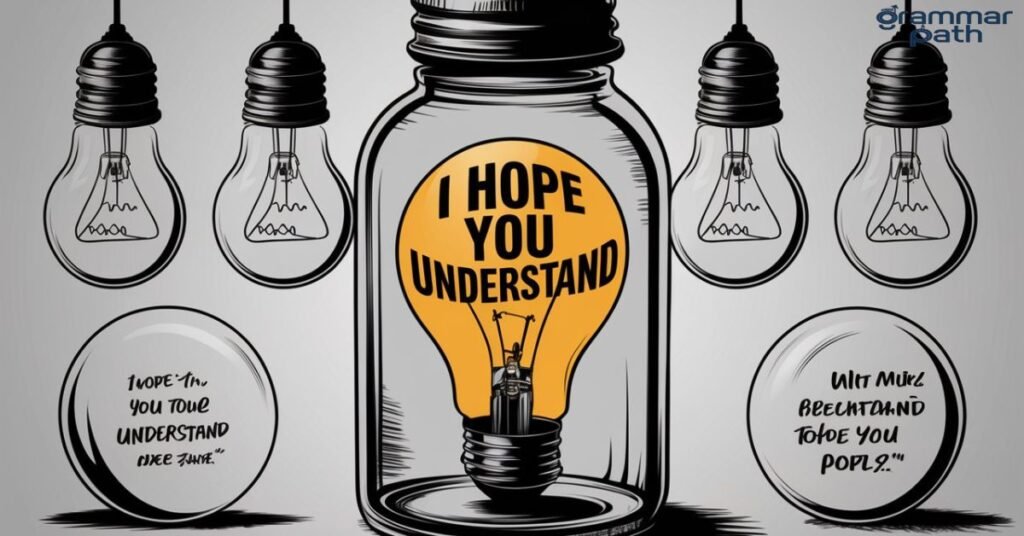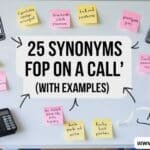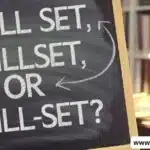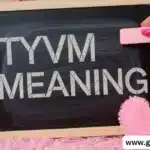Communication isn’t always a walk in the park. We’ve all been there, struggling to find the right words to convey our thoughts and feelings. “I hope you understand” is a phrase we often fall back on, but let’s face it – it can sound a bit stale after a while. What if I told you there are other ways to express this sentiment that could breathe new life into your conversations?
Picture this: You’re crafting an important email to your boss, explaining why you need an extension on a project deadline. You want to convey your situation clearly without sounding like a broken record. Or maybe you’re having a heart-to-heart with a friend, trying to explain a complex emotional situation. In both cases, you need words that resonate, that truly connect.
That’s where this article comes in handy. We’re about to dive into a treasure trove of alternatives to “I hope you understand” – phrases that can add color, depth, and nuance to your communication. From casual catchphrases like “Do you catch my drift?” to more formal expressions like “I’d like to know your thoughts,” we’ve got you covered. So, buckle up and get ready to supercharge your vocabulary!
is it Professional to Say: “I hope you understand”
While “I hope you understand” is commonly used, it may not always be the most professional choice. In formal settings, it can sound uncertain or passive. More assertive alternatives often convey confidence and clarity better.
However, context matters. In some situations, this phrase can show empathy. The key is to gauge your audience and the situation, choosing language that balances professionalism with sensitivity to maintain effective communication.
What to Say Instead of “I Hope You Understand”
- Do You Catch My Drift?
- Let’s Ensure We’re on the Same Page
- I’d Like to Know Your Thoughts
- May This Resonate with You
- I’m Counting On Your Understanding
- I’m Shooting for Clarity
- I’d Love to Hear Your Take
- Let’s Make Sure We’re in Sync
- Please Let Me Know if This Makes Sense
- Is This Registering with You?
- I Trust This Aligns with Your Understanding
- Can We Get on the Same Wavelength?
- I’m Aiming for Crystal Clear Communication
- Does This Resonate with Your Perspective?
- I’m Hoping We’re Aligned on This
- Can You See Where I’m Coming From?
- I’d Appreciate Your Take on This
- Let’s Make Sure We’re Not Missing Anything
- I’m Keen to Ensure We’re on the Same Page
- Does This Jive with Your Understanding?
- I’m Striving for Mutual Understanding Here
- Can We Reach a Shared Understanding on This?
- I’m Hoping This Clicks with You
- Let’s Ensure We’re Reading from the Same Script
- I’d Appreciate Your Feedback on My Perspective
- Can We Sync Our Wavelengths on This?
- I’m Aiming for Complete Transparency Here
- Does This Align with Your Take on Things?
- I’m Striving for Mutual Comprehension
- Can We Reach a Meeting of Minds on This?
1. Do You Catch My Drift?
This casual phrase is perfect for informal situations where you want to check if someone’s following your train of thought. It’s like asking, “Are you picking up what I’m putting down?” but with a bit more flair.
Example scenario (Text message): “Hey Alex, I’m running late for our meetup. Traffic’s a nightmare, and I forgot my wallet at home. Might need to raincheck. Do you catch my drift? Let me know if you’re cool with rescheduling.”
2. Let’s Ensure We’re on the Same Page
When clarity is key, this phrase helps ensure everyone’s aligned. It’s particularly useful in professional settings or when discussing complex topics.
Example scenario (Email): “Dear Team, I’ve outlined the project milestones in the attached document. Let’s ensure we’re on the same page regarding deadlines and deliverables. Please review and let me know if you have any questions or concerns. Best regards, Sarah”
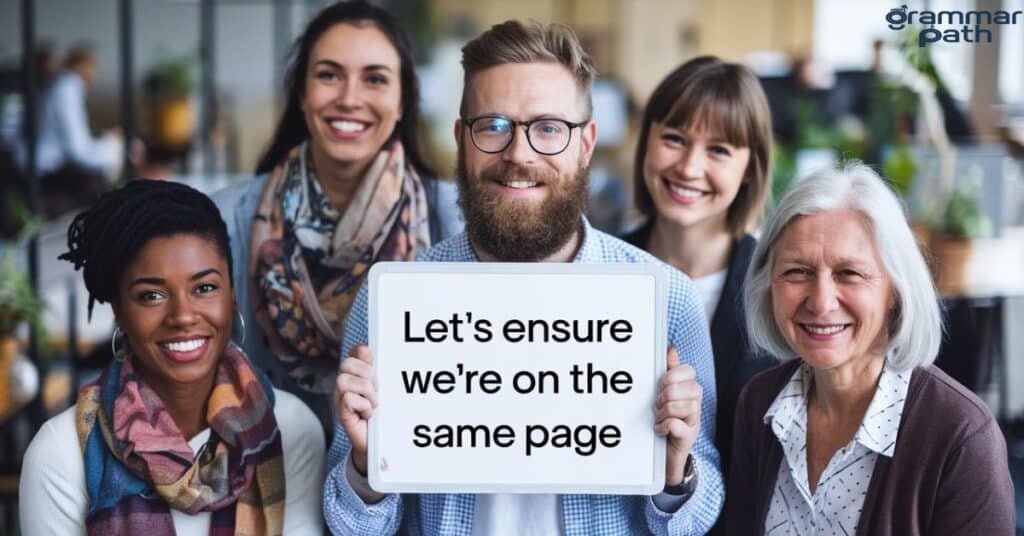
3. I’d Like to Know Your Thoughts
This open-ended phrase invites the other person to share their perspective, showing that you value their input and understanding.
Example scenario (In-person conversation): “I’ve explained my reasons for wanting to switch departments. I’d like to know your thoughts on this, boss. Do you think it’s a viable move for both me and the company?”
4. May This Resonate with You
Use this when you’re sharing something personal or profound, hoping it strikes a chord with the listener.
Example scenario (Public speaking): “As I wrap up this talk on overcoming adversity, I hope my journey and lessons learned may resonate with you. Remember, every setback is a setup for a comeback.”
5. I’m Counting On Your Understanding
This phrase conveys a bit more urgency and importance. It’s like saying, “I really need you to get this.”
Example scenario (Work chat): “Hi Lisa, I know the report’s due today, but I’m dealing with a family emergency. I’m counting on your understanding here. Is it possible to get a 24-hour extension?”
6. I’m Shooting for Clarity
When you want to emphasize that you’re doing your best to explain something clearly, this phrase fits the bill.
Example scenario (Teaching): “Alright, class. I’m shooting for clarity on this complex algebra problem. Let’s break it down step by step. Stop me if anything’s unclear, okay?”
7. I’d Love to Hear Your Take
Similar to asking for thoughts, this phrase encourages feedback in a more enthusiastic way.
Example scenario (Friend discussion): “I’ve been mulling over a career change. I’d love to hear your take on it, given you’ve been through something similar.”
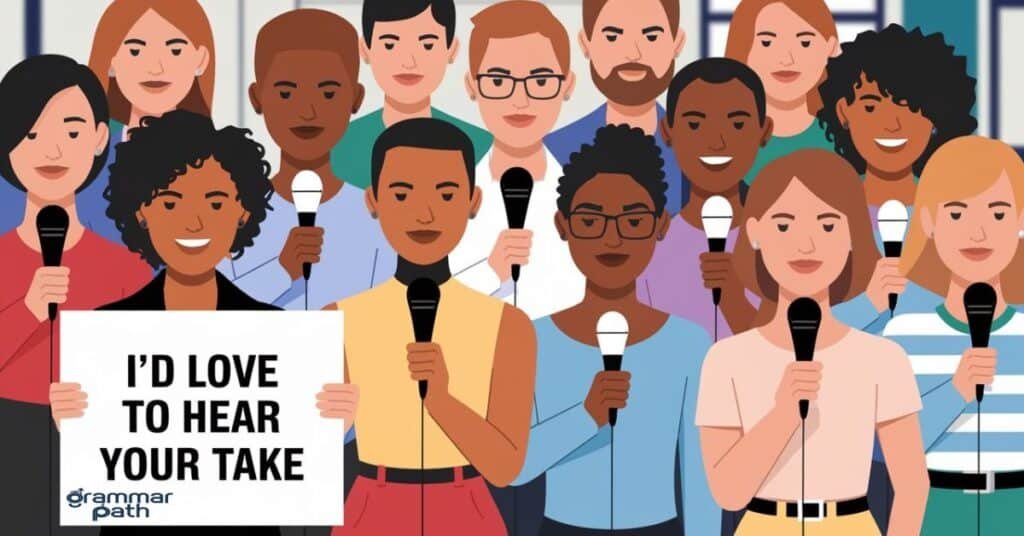
8. Let’s Make Sure We’re in Sync
This phrase is great for team settings where alignment is crucial.
Example scenario (Team meeting): “Before we wrap up, let’s make sure we’re in sync on the project timeline. Any questions about the next steps or deadlines?”
9. Please Let Me Know if This Makes Sense
A polite way to check for understanding, especially useful in written communication.
Example scenario (Customer service email): “I’ve outlined the troubleshooting steps for your device. Please let me know if this makes sense or if you need further clarification.”
10. Is This Registering with You?
A more casual way to check if someone’s following along, often used in verbal conversations.
Example scenario (Explaining a concept): “So, quantum physics isn’t about tiny particles, but about probabilities and waves. Is this registering with you, or should I try a different analogy?”
11. I Trust This Aligns with Your Understanding
This phrase conveys confidence while still leaving room for confirmation.
Example scenario (Business proposal): “Based on our previous discussions, I’ve drafted this proposal. I trust this aligns with your understanding of our potential partnership.”
Pro Tips: The most crucial paragraph in this article is the one explaining the importance of context and tone in choosing the right phrase. Understanding your audience and the situation is key to selecting the most appropriate alternative to “I hope you understand.” Whether you’re in a professional setting, having a heart-to-heart with a friend, or explaining a complex concept, the right phrase can make all the difference in ensuring your message is received as intended.
12. Can We Get on the Same Wavelength?
A casual, friendly way to seek agreement or shared understanding.
Example scenario (Friend disagreement): “I feel like we’re talking past each other. Can we get on the same wavelength about this vacation plan?”

13. I’m Aiming for Crystal Clear Communication
Use this when you’re putting extra effort into being understood.
Example scenario (Technical explanation): “I’m aiming for crystal clear communication here. The new software update will affect these three key areas of our workflow…”
14. Does This Resonate with Your Perspective?
This phrase invites the other person to compare your view with theirs.
Example scenario (Therapy session): “I’ve shared my feelings about the situation. Does this resonate with your perspective on what’s been happening?”
15. I’m Hoping We’re Aligned on This
A good phrase for seeking agreement in professional settings.
Example scenario (Team project): “I’m hoping we’re aligned on this approach to the client presentation. Any concerns or suggestions before we move forward?”
16. Can You See Where I’m Coming From?
This asks the listener to try to understand your point of view.
Example scenario (Relationship discussion): “I know my reaction might seem strong, but given my past experiences, can you see where I’m coming From?”
17. I’d Appreciate Your Take on This
A polite way to ask for someone’s opinion or understanding.
Example scenario (Mentorship): “I’ve outlined my career goals for the next five years. I’d appreciate your take on this plan, given your experience in the industry.”
18. Let’s Make Sure We’re Not Missing Anything
This phrase is useful when you want to ensure comprehensive understanding.
Example scenario (Project planning): “We’ve covered a lot of ground today. Let’s make sure we’re not missing anything critical before we adjourn.”

19. I’m Keen to Ensure We’re on the Same Page
This expresses enthusiasm for mutual understanding.
Example scenario (New partnership): “As we embark on this collaboration, I’m keen to ensure we’re on the same page regarding expectations and deliverables.”
20. Does This Jive with Your Understanding?
A more casual, colloquial way to check for agreement.
Example scenario (Friend explaining a situation): “So that’s why I decided to move out. Does this jive with your understanding of what went down?”
21. I’m Striving for Mutual Understanding Here
This phrase emphasizes the effort you’re putting into clear communication.
Example scenario (Conflict resolution): “I know we’ve had our differences, but I’m striving for mutual understanding here. Can we talk through this calmly?”
22. Can We Reach a Shared Understanding on This?
Use this when you’re actively working towards agreement.
Example scenario (Business negotiation): “We’ve discussed the terms at length. Can we reach a shared understanding on this contract before we proceed?”
Pro Tips: When incorporating these new phrases into your communication toolkit, remember that context is key. The most effective communicators adapt their language to suit the situation and their audience. For instance, “Can we sync our wavelengths on this?” might be perfect for a casual chat with a colleague, but “I’m striving for mutual comprehension” could be more appropriate in a formal business setting.
23. I’m Hoping This Clicks with You
This phrase is perfect for when you want to express your desire for the other person to grasp your point intuitively.
Example scenario (Explaining a new concept):
“So, think of blockchain like a digital ledger that everyone can see but no one can alter. I’m hoping this clicks with you. It’s a game-changer for transparency in transactions.”
24. Let’s Ensure We’re Reading from the Same Script
Use this when you want to emphasize the importance of everyone being on the same page, especially in collaborative settings.
Example scenario (Team project kickoff):
“Before we dive into the tasks, let’s ensure we’re reading from the same script regarding project goals and timelines. Any questions about our overall direction?”
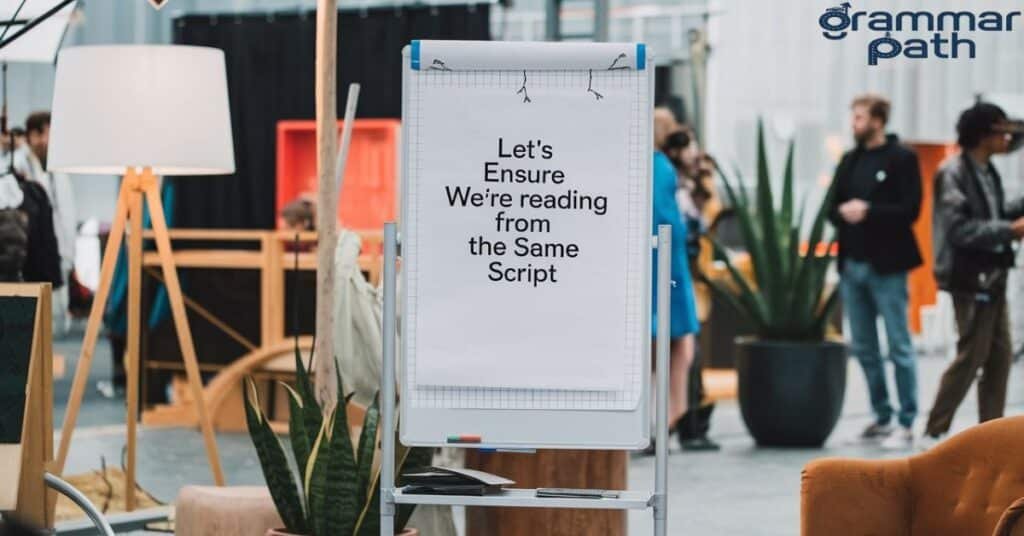
25. I’d Appreciate Your Feedback on My Perspective
This phrase invites the other person to engage with your viewpoint and offer their insights.
Example scenario (Performance review):
“I’ve outlined my achievements and areas for growth this quarter. I’d appreciate your feedback on my perspective. Have I missed anything crucial?”
26. Can We Sync Our Wavelengths on This?
A more playful, informal way to ask if you’re both understanding the same thing.
Example scenario (Friend planning):
“Alright, so for the road trip: snacks, playlists, and emergency kit. Can we sync our wavelengths on this? Anything else you think we need?”
27. I’m Aiming for Complete Transparency Here
“Use ‘I Hope You Understand‘ when you want to emphasize your effort to be clear and open in your communication.”
Example scenario (Addressing team concerns):
“I know there have been rumors about company restructuring. I’m aiming for complete transparency here: let me walk you through what’s actually happening and how it might affect us.”
28. Does This Align with Your Take on Things?
This phrase asks the listener to compare their understanding with what you’ve presented.
Example scenario (Discussing a shared experience):
“I’ve shared my recollection of how the project unfolded. Does this align with your take on things, or did you experience it differently?”
29. I’m Striving for Mutual Comprehension
Use this when you want to emphasize the effort you’re putting into ensuring both parties understand each other.
Example scenario (Cross-cultural business meeting):
“As we discuss these contract terms, I’m striving for mutual comprehension. Please feel free to stop me if any concepts need more explanation or cultural context.”

30. Can We Reach a Meeting of Minds on This?
This phrase is useful when you’re working towards agreement or shared understanding on a complex issue.
Example scenario (Negotiation):
“We’ve laid out both sides of the argument. Can we reach a meeting of minds on this compromise, or do we need to explore other options?”
Conclusion
In the grand tapestry of human interaction, words are the threads that weave connections. By expanding your repertoire beyond the tried-and-true “I hope you understand,” you’re adding vibrant new colors to your conversational palette. These 30 alternatives offer you a range of expressions to fit various contexts, from the boardroom to the living room.
Remember, the goal isn’t just to sound different – it’s to communicate more effectively. Each of these phrases, when used thoughtfully, can help bridge gaps in understanding, foster empathy, and create stronger connections. Whether you’re shooting for clarity in a professional email or trying to resonate with a friend during a heart-to-heart, these alternatives give you the tools to express yourself with nuance and precision.

Emily Olivia is an experienced writer specializing in grammar and English language topics. With a passion for clarity and precision, she shares valuable insights on synonyms, grammar rules, and writing tips to help readers enhance their language skills on Grammar Path.

